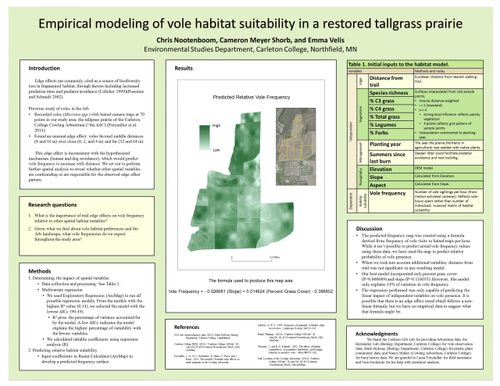Environmental Studies courses currently using the Cowling Arboretum for an outdoor classroom are: ENTS 225 Carbon and Climate and ENTS 288 Abrupt Climate Change.
Environmental Studies (ENTS) students have the opportunity to learn skills in geospatial modeling using the computer software ArcGIS. Students in Introduction to Geospatial Analysis (ENTS 120), taught by Tsegaye Nega and Wei-Hsin Fu, complete a final project in which they generate maps using real data to answer a research question of interest to them. Several student groups in the past have used the Arb as a study site.
Chris Nootenboom ’16, Cameron Shorb ’16, and Emma Velis ’17 studied whether the “edge effects” of trails in the Arboretum had an impact on which habitat voles (a common small mammal) choose to live in. They compared vole sightings from camera traps to landscape characteristics, and found that proximity to trails was not actually a significant predictor of vole location. Slope and grass cover were the most important factors in making habitat suitable for voles. Click on the pdf link to the right to read their poster in more detail!

In another interdisciplinary ENTS course, Environmental Ethics (215), Professor Kim Smith finds that the Arboretum lends itself to many of the questions and issues explored the course. Students go on an Arb tour, and walk alone in the Arb, and write and reflect on these experiences. The Arb allows her class to study “how learning about a landscape affects one’s relationship to it,” which engages students in lessons on environmental aesthetics.
The Arb also enables students to conduct research projects concerning the ethical implications of environmental management, considering questions like:
- Is allowing deer hunting ethical?
- How should feral cats be dealt with?
- Should the Director implement an assisted migration program to help preserve endangered species?
- Is using fire an ethical land management practice?”